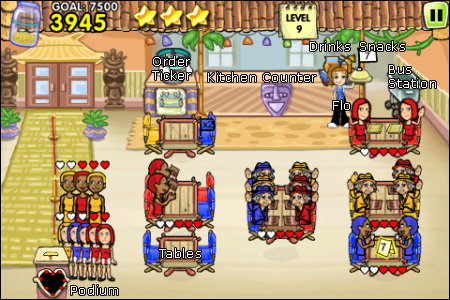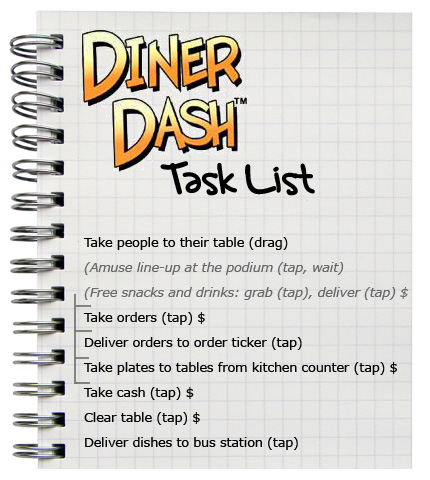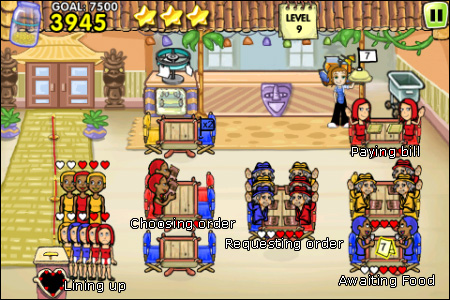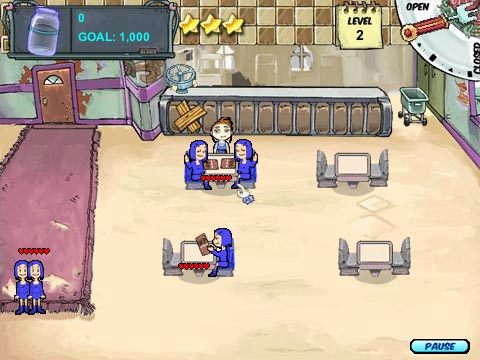Diner Dash and Interactive Capitalism
December 20th, 2010
Diner Dash is such a fascinating title to me because of its simulation and critique of capitalism in the food industry. Before we get to that part though, we need to first examine the task list and combo system which define Diner Dash‘s core gameplay.
Overview
In Diner Dash you play as restaurant-owner-cum-waitress Flo starting up her own business venture. The main goal is rake in more and more customers in the pursuit of earning more money and therefore expanding the franchise with additional restaurants. I played the iPod version as seen in the video above. You can try a demo of Diner Dash here. Otherwise there are versions for the Steam, WiiWare, PSN and other download services.
Points of Interaction
Diner Dash is a single screen game, all points of interaction are labelled in the screenshot below. There isn’t, however, a snack stand in this screenshot. As you can see by the labels, it would sit right next to the drink dispenser. Snacks come into play in the later levels of the game.
Task List
All interactions in Diner Dash are based around tapping or dragging. Such simplicity means that there is little to say about the mechanics other than the input method suits the action quite well. For example, dragging customers is to lead them to their table, tapping is to pick up or unload something. Diner Dash is about the mastery of procedure (the tasks involved in the running of the restaurant) and not the mastery of core mechanics. So let’s first start by observing what is required of Flo to fill the bellies and floss the wallets of customers.
The greyed text are non-mandatory actions. These interactions can be used to control the flow of customers, keep them happy and avoid any combo interrupts. We’ll get to this stuff later though. For now, notice that snacks and drinks can be given to customers at anytime while they are sitting in their seats. Also note the interactions marked with dollar signs. Cash is gained each time the player does these $ actions (not including colour matching). The video below demonstrates the bare bones process:
http://www.youtube.com/watch?v=a-5fccghRPw
3 Ways to Multiply Your Money
The goal of Diner Dash is to obviously make money, but simply sending customers through on it’s own isn’t enough. There are 3 abstract systems which add or multiply you score. That is, how much money you can earn. These systems become increasingly more important as the money (ie. point) requirement in each stage increases.
Hearts
As you can see by the screenshots, each set of customers has 5 hearts floating above their head which represents their level of satisfaction. The quicker you set them down, take their orders and deliver their food, the more satisfied they will be. When the customers come to pay for the meal, their tip is dependent upon the number of hearts, so you want to get the job done quickly.
The screenshot above shows the different states of the customer throughout the process. When the customer is either lining up, requesting an order, awaiting food or ready to pay the bill, an invisible timer will be counting down. As the waiting time for the customers increases they become visibly agitated, before finally losing a heart of satisfaction. If a set of customers wait too long their hearts will decrease until they storm out in anger, cutting a chunk out of your profit.
Hearts can be replenished by giving the customers free drinks or snacks or talking to the them while they wait in front of the podium.
Different types of customers become impatient at different rates or more or less impatient when in certain states. For example: Mr. Hot Shot. These types of customers can wait patiently in line but have no patience when it come to being seated.
Colour Match
You may have also noticed that the customers and chairs are coloured. If you match the customers wearing certain coloured clothing with the respective coloured chairs then you will gain $100 for every match. An additional multiplier on the base $100 is added for every consecutive same colour, same chair match thereafter. So, for example, match the same colour 3 times in a row and the cash goes up to $300.
(Actually resorting the arrangement of set customers as you’ve got they over the tables is incredibly finicky on the iPod. You might have a group of 3 customers with one wearing red, actually shifting him onto the red seat requires some random sliding on the spot. Play First would have been better off automating it, so that the game chose the best matches for the player).
Repeated Actions (Action Chain Bonus)
As we know, for each $ interaction money is added to the player’s piggy bank. This amount of money is doubled if the $ interaction is repeated. For example, maybe 2 sets of customers enter and are seated, you take the order of the first set and gain $20, then you take the second set and gain an extra $40. This reward system is called an “action chain bonus”, which basically can be interpreted as an “efficiency” multiplier.
Expansion
In Diner Dash, profit is proportional to difficulty. This is enforced in each level as a cash requirement which must be met to advance to the next stage (otherwise the player must retry). Therefore as profit increases and the players advance to higher stages, the profit is used to buy new nicknaks for the restaurant. Each of these items adds a new wrinkle of variation and difficulty to the game. For example:
podium
- Flo can stand at the podium and talk to qued customers to refill their hearts. The podium becomes a crutch to manage the flow of customers and boost the satisfaction of waiting customers. It makes sense to retreat to the podium when the seated customers are eating or the food is being cooked.
larger tables or long counters
- Different sized tables give the player new constraints to work and strategise within.
snack station
- Snacks can be used to please dissatisfied customers or, as becomes frustratingly frequent later in the game, customers will request snacks, in effect snacks act as combo interupts as dishing out snacks will create a new combo.
drink station
- Same as snacks.
Playing to Win
The goal of each level is to meet the requisite dollar value to progress to the next stage. In this case, exploiting the most out of the abstract systems is critical to success. As mentioned, there are 3 ways that the player can make more money: more customer satisfaction (hearts), colour matching customers and chairs, and the action chain bonus system, so doing the same $ task in succession.
Of all three methods the action chain bonus system is the most effective. Refer back to either one of the 2 screenshots above and count the number of tables. 7 tables. Consider this, each time you take an order you gain $20 and the multiplier increases by one value. So, taking the orders for 7 tables will net you $1280. Now, when you deliver the food the player gets $30 a table, $50 for taking the cash and $40 for taking the dishes. Add up all of those possibilities and it’s easy to see how the action chain bonus rakes in the dough.
As for the other 2 methods. The hearts only determine the tip at the end which may be around $100 per customer, so really, looking after the customer’s level of satisfaction isn’t so important. The customer’s favourite colour also doesn’t mean a great deal as colour matching is tricky and time consuming, an overall hindrance to the action chain bonus.
http://www.youtube.com/watch?v=bi12cvrIKygThe action chain bonus is a system, which earns the player the most amount of money, is best exploited by the player lining up groups of customer sets and repeating the same $ action. Diner Dash supports the player maxing out this technique by continually adding tables to each level, allowing for bigger lines of actions to chain. The video above is a nice demonstration.
To make Diner Dash more challenging, the snack and drink stations are used to break the players combos. It’s not the stations themselves that break combos, but the customers that request food and drink from them. As you plant customers in their seats and run through the various states, lining up repeatable $ tasks and all that, some customers will request a snack or drink and change their state to a “request food/drink” state. Giving the customers the snacks and drinks they request will start another chain combo and cancel the current one. Since it’s random whether or not the customers will request a snack, drink or simply not request at all, and the window open to meeting these requests is quite narrow, these devices are an unstable way of building combos. Food and drink requests are effectively a way to hinder the player from building up more chains. This is why I’ve dubbed these extra requests as “interupts” (refer to video for examples).
At this point the player has 2 options: give the customers the drink or snack that they are requesting or wait until the customer becomes impatient, loses a heart of satisfaction and reverts back to their prior state, continuing as before. Of course, smart players know that the heart-dependent tip at the end counts for very little, making it an easy sacrifice in the face of the action chain bonus. In fact, by the time Flo becomes a mystical 4-handed God in the final restaurant, the number of chains amounts to such a rich profit that even customer walkouts aren’t a huge deal. Of course, they should be avoided, but if it happens, it’s only a $1000 loss in the face of chains of $1000+ being made every 20 seconds.
Through all the money making, a clear strategy emerges (refer to video if needed):
- Stand at the podium until all customers are maxed out with hearts
- Place customers in their seats
- Go back to the podium to keep waiting customers maxed out and wait until all seated customers are ready to order and most of the snack/drink requests have or, by the time you get the customer, will have expired
- Take orders
- Take the orders to the ticker
- By the time you’ve dropped the last few orders, the first dishes will be ready, send them out
- As seated customers eat, head back to the podium and amuse the waiting customers
- Again, ignore all requests for snacks and drinks, unless customers are threatening to storm out
- Take money, can head back to podium and wait for slow eaters
- Take the rest of the money
- Clear dishes
Interactive Capitalism
Watch from 5:10
http://www.youtube.com/watch?v=zchsu7emVEsSo what does all this have to do with capitalism and the food industry? Watch the video above and see if you can catch the connection.
“They trained each worker to do one thing again, again and again.”
Diner Dash is an interactive model of the modern food system in restaurants as it privileges repetitive actions within a restaurant context. Flo’s diner is a one-man factory. There is one single most effective strategy to run the factory and that creates a uniform style of play. Flo’s wealth only increases more and more until the game must create a faux ending where Flo becomes a 4-handed God. In one sense, Diner Dash could be rebranded and tweaked to become McDonalds: The Game.
Despite this connection, you may be wondering what the factory model of cooking has to do with capitalism? Well, the factory model of food production and delivery is the cheapest means of production. Cheapening production is the easiest and most typical way to fulfil the profit motive: the core tenet of capitalism. Therefore, Diner Dash uses a capitalist model of food production and Flo/the player is the agency that sets the system in motion. My argument is based on 2 facts that have been established so far:
- The player’s motivation and the motivation behind capitalism are the same: profit. If the player can’t gain more profit, the game goes nowhere. If corporations don’t keep earning more and more profit, the free market dies.
- The best way to meet profit expectations is to rely on a safe, mechanised means of production. For contemporary capitalism, this means is the factory. In factories workers repeat a given set of actions over and over, as does the Flo/the player in the game. Both capitalism and Diner Dash are factory systems.
A few points of clarification are needed though. By production, I mean the entire process up to the point of consumption as the delivery itself is part of the production process. While this may seem dubious to my argument, it’s really only a matter of context and no matter what context, the rules of Diner Dash and the rules of capitalism are still analogous. (This is, like most of the writing here, a discussion of the underlying rule systems). But if you still need further proof, why not take the switch out my analysis of Diner Dash for the Cooking Dash variant. Both games have the same core systems, but the latter is better suited to the appearances of the analogy. Let’s carry on…
(Cooking Dash)
Since Diner Dash and capitalism share many properties, arguments for and against capitalism can be made through Diner Dash.
Pro-capitalism Arguments
In the same way the player comes to master the strategy that I dot-pointed earlier and aggressively stick to it, people in business have such an endearing dogma towards this property of the free market. Once either player (gamer or businessman) realises that this strategy of factory-style labour is the most effective for winning (the game or the market), then there is little reason to change.
In Diner Dash, uniformity of production is privileged through the action chain bonus system, as is the case in capitalism and standardisation of product.
Capitalism is based around the profit motive in the same way Diner Dash is based around the score motive.
Diner Dash is a game about expansion (see expansion heading above) just like capitalism is a model of continual progression. Where capitalism seeks to advance new technologies for the sake of even cheaper production (in allegiance to the profit motive), Diner Dash expands the set of items in the restaurant and arguably the depth of the gameplay.
Just like other games which model capitalism (GTA and Osmos, for example), the game ends when a peak is reached.
Anti-capitalism Arguments
Flo may be making a great deal of profit, but by way of turning herself into a robot. There are people that have to work in these factories and humanity isn’t something that melds too well with the profit motive. The irony being that Diner Dash is fundamentally the same as work, except that because the player draws enjoyment from being in a position of “control”.
Diner Dash is a little unique here in that the worker of the restaurant is also the boss. Despite this, Diner Dash still presents a workers vs profit motive argument which can be interpreted as waitress Flo vs Flo the boss.
Capitalism is successful often to the exploitation of resource which includes people’s quality of life and the environment. Diner Dash presents this in 3 ways:
- the mechanisation of Flo’s working life
- the lack of space in the gameplay for the player to seat the customers in their favourite coloured chairs (read: the game disallowing the player from easily making the customers happy)
- the player having to discredit the happiness of others to meet the profit motive (action chain bonus, snack and drink interrupts). Even if this means customers will walk out angry.
Marxist critique of capitalism says that capitalism will end either by a workers revolution or a complete and utter breakdown of the system. Before the system breaks down altogether though, there will be a series of minor collapses (think strokes), before the system fails altogether. Critics of capitalism believe that the world financial crisis was such an example and that, as according to Marx, the solution to the problem will only be a band-aid one. For example: the conservatives in the UK cutting public expenditure, raising university fees and blaming the populace for being so greedy. America’s bail out plan of giving money back to the banks and fat cats as another example. Capitalism cannot be restrained or regulated, it can only be removed.
We see this exact problem in Diner Dash‘s design. The only way for Diner Dash to increase difficulty is to lump more things at the player’s task list. This works okay for a while, before the design becomes cluttered (again, this video, now imagine it on a small iPod screen!), making Diner Dash too difficult to visibly determine core elements, too tricky to tap them and slows down the speed of the device dramatically. Like capitalism, Diner Dash responds with a band aid solution: give Flo 4 arms! This solution is obviously quite ridiculous, but it works for a few levels until, say maybe the final level, where Flo’s use of the chain system in conjunction with her new arms gives her an enormous advantage and the profit level is off the charts. For example, I scored $69,855 in the final level, nearly 2.5 times the goal of $26,000 and a tad shy of double the expert score of $35,000. You’d think that the only way to fix this would be to add more tables and interupts, but this would only further clutter gameplay. The difficulty goes totally out of whack (in the same way the multinational corporations are making unbelievable profit) and the only way to repair the game (or capitalism) to remove it and start again.
Conclusion
I’ll admit that as a socialist it’s difficult for me to say anything nice about capitalism, so even my pro-capitalist arguments are thinly-disguised criticisms, but regardless of that, we can see how through the player’s motivation to reach a dollar score to advance and through the way repeated actions are privileged, Diner Dash’s gameplay system is analogous to capitalism. From this, we can use Diner Dash as a means to talk politically. Furthermore, even without the player having any sense of it, they are participating in this system of economics and subconsciously interpreting it. Video games, like economic systems, are simply that, systems. Akin to the same link between video games and education or the rules of nature, gameplay can act as a window for us to further our understanding of the underlying systems around us.








 Game Design Companion: A Critical Analysis of Wario Land 4 - $7.99
Game Design Companion: A Critical Analysis of Wario Land 4 - $7.99 Level Design: Processes and Experiences
Level Design: Processes and Experiences Speed Boost: The Hidden Secrets Behind Arcade Racing Design - $5.99
Speed Boost: The Hidden Secrets Behind Arcade Racing Design - $5.99 Adventures in Games Analysis: Volume I - $5.99
Adventures in Games Analysis: Volume I - $5.99







